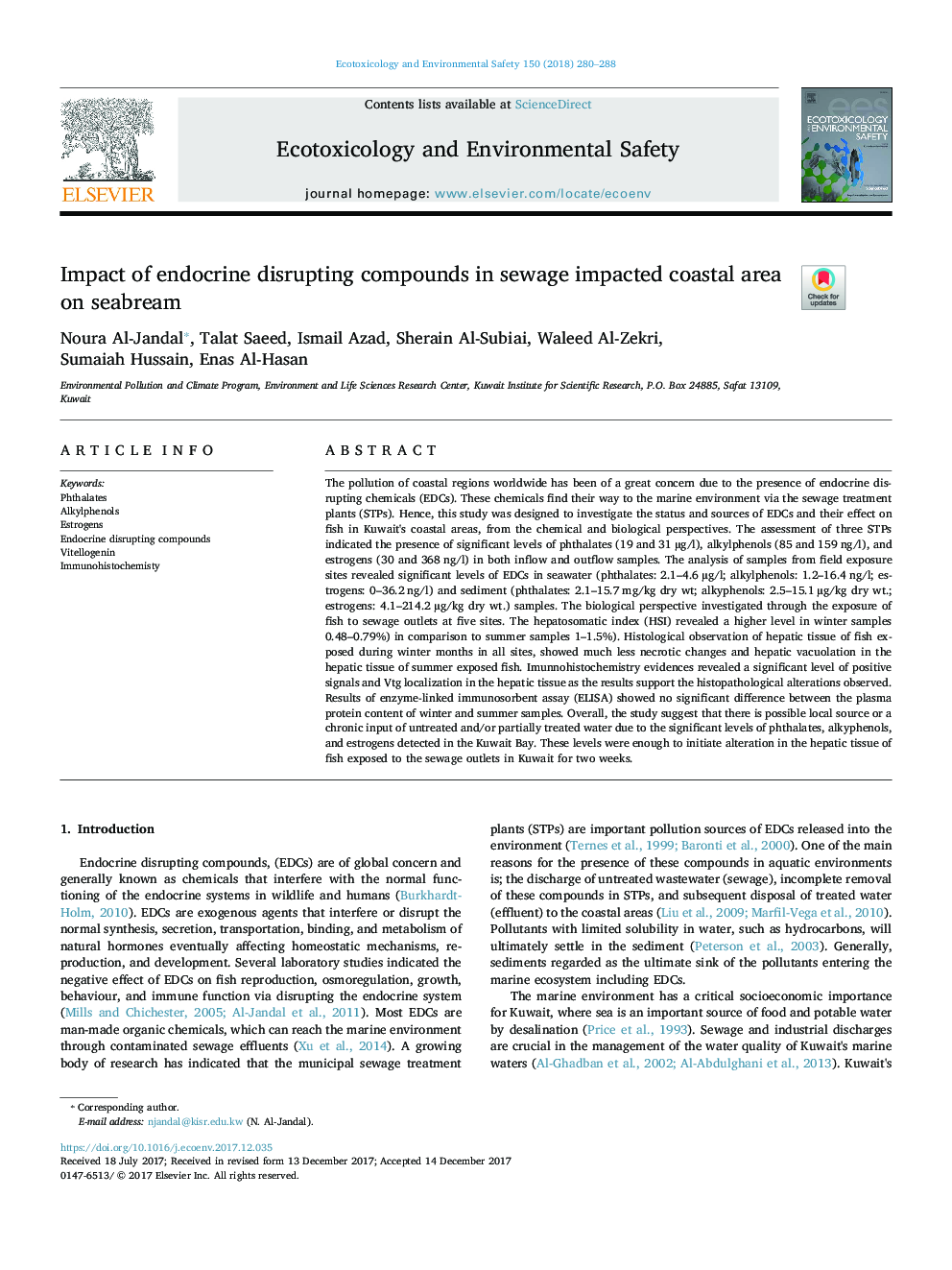| کد مقاله | کد نشریه | سال انتشار | مقاله انگلیسی | نسخه تمام متن |
|---|---|---|---|---|
| 8854388 | 1618914 | 2018 | 9 صفحه PDF | دانلود رایگان |
عنوان انگلیسی مقاله ISI
Impact of endocrine disrupting compounds in sewage impacted coastal area on seabream
ترجمه فارسی عنوان
تأثیر ترکیبات غشایی غدد درونریز در مناطق ساحلی تحت تاثیر فاضلاب بر روی ساحل
دانلود مقاله + سفارش ترجمه
دانلود مقاله ISI انگلیسی
رایگان برای ایرانیان
کلمات کلیدی
موضوعات مرتبط
علوم زیستی و بیوفناوری
علوم محیط زیست
شیمی زیست محیطی
چکیده انگلیسی
The pollution of coastal regions worldwide has been of a great concern due to the presence of endocrine disrupting chemicals (EDCs). These chemicals find their way to the marine environment via the sewage treatment plants (STPs). Hence, this study was designed to investigate the status and sources of EDCs and their effect on fish in Kuwait's coastal areas, from the chemical and biological perspectives. The assessment of three STPs indicated the presence of significant levels of phthalates (19 and 31 µg/l), alkylphenols (85 and 159 ng/l), and estrogens (30 and 368 ng/l) in both inflow and outflow samples. The analysis of samples from field exposure sites revealed significant levels of EDCs in seawater (phthalates: 2.1-4.6 µg/l; alkylphenols: 1.2-16.4 ng/l; estrogens: 0-36.2 ng/l) and sediment (phthalates: 2.1-15.7 mg/kg dry wt; alkyphenols: 2.5-15.1 µg/kg dry wt.; estrogens: 4.1-214.2 µg/kg dry wt.) samples. The biological perspective investigated through the exposure of fish to sewage outlets at five sites. The hepatosomatic index (HSI) revealed a higher level in winter samples 0.48-0.79%) in comparison to summer samples 1-1.5%). Histological observation of hepatic tissue of fish exposed during winter months in all sites, showed much less necrotic changes and hepatic vacuolation in the hepatic tissue of summer exposed fish. Imunnohistochemistry evidences revealed a significant level of positive signals and Vtg localization in the hepatic tissue as the results support the histopathological alterations observed. Results of enzyme-linked immunosorbent assay (ELISA) showed no significant difference between the plasma protein content of winter and summer samples. Overall, the study suggest that there is possible local source or a chronic input of untreated and/or partially treated water due to the significant levels of phthalates, alkyphenols, and estrogens detected in the Kuwait Bay. These levels were enough to initiate alteration in the hepatic tissue of fish exposed to the sewage outlets in Kuwait for two weeks.
ناشر
Database: Elsevier - ScienceDirect (ساینس دایرکت)
Journal: Ecotoxicology and Environmental Safety - Volume 150, 15 April 2018, Pages 280-288
Journal: Ecotoxicology and Environmental Safety - Volume 150, 15 April 2018, Pages 280-288
نویسندگان
Noura Al-Jandal, Talat Saeed, Ismail Azad, Sherain Al-Subiai, Waleed Al-Zekri, Sumaiah Hussain, Enas Al-Hasan,
